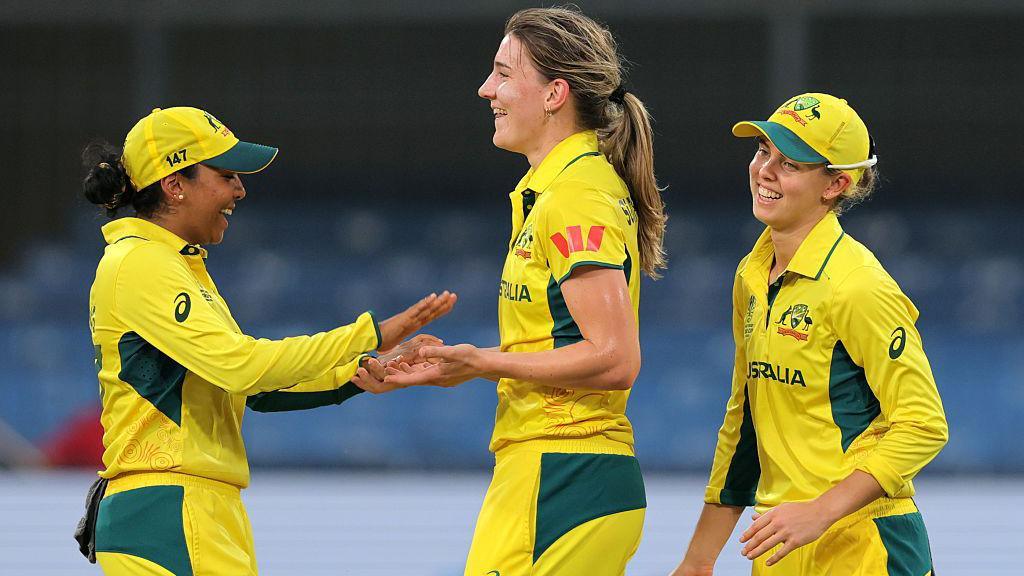 Image source, Getty Images
Image source, Getty Images
Annabel Sutherland (middle) is the tournament's joint-leading wicket-taker
ByFfion Wynne
BBC Sport journalist in Guwahati
At the conclusion of the group stage of the Women's World Cup and with the semi-finals on the horizon, one specific question has been doing the rounds throughout.
How do you beat Australia?
The defending champions have reached the knockouts unbeaten, the group stage culminating in their most convincing win so far as they bowled out South Africa - who are England's semi-final opponents - for just 97.
Even their biggest wobble - the slump to 76-7 against Pakistan - ended up being a showcase of why they are such heavy favourites, as Beth Mooney's century revived them to 221-9.
They rightly have unwavering confidence in their staggering batting depth, and part of what makes them so hard to beat is the sheer amount of all-rounders. Of the XI that beat England comfortably in Indore, eight of them were genuine bowling options.
Australia slipped to 68-4 in that game, but even then, captain Alyssa Healy said there was no doubt they would get over the line.
"It's been the nature of the tournament where teams have struggled at the top," Healy told BBC's No Balls podcast.
"I've been saying the whole way you've got to back your depth. They keep stepping up, sticking their hands up and getting the job done no matter the situation.
"There was frustration [against England] but no, I don't think there was ever any worry."
Between the 2022 World Cup and the start of this edition, Australia played 31 one-day internationals, winning 26 and losing four, with one washed out.
They have not lost a World Cup game since being knocked out in the last four by India in 2017, which kickstarted this phenomenal run.
However, those rare defeats have come against the other semi-finalists, with two against England in the 2023 Ashes and one each against India and South Africa.
BBC Sport and data analysts CricViz have looked at the statistics at the end of the group stage to see their greatest strengths and whether there are any weaknesses in their game for opponents to target.
ICC Women's Cricket World Cup semi-finals
29 & 30 October, 2025
In-play clips and highlights on BBC Sport website and app. Ball-by-ball commentary on BBC Sounds, BBC Radio 5 Sports Extra and the BBC Sport website and app
What makes Australia so good?
It is the aforementioned batting depth which has set Australia apart from the rest for the past few years of dominance.
They have the formidable luxury of Tahlia McGrath at seven and Georgia Wareham at eight (when she can get in the side), meaning that even if a top-order wobble occurs, they have a lengthy safety net - and crucially, they have the grit and mentality from 1-11 so that someone always catches them.
It also means they can be more aggressive earlier, and take more risks rather than worrying about wickets in hand. That is showcased by their powerplay run-rate of 6.26, the highest in the tournament, and their strike-rates of 107.2 against pace and 92.3 against spin.
Crucially, this also makes their batting a team effort with no particular dependency on one or two world-class players.
They are averaging 73 for the first wicket - although that was as high as 89.8 when Healy was with Phoebe Litchfield - even before you get to the powerhouses in the middle.
Skipper Healy and Ash Gardner - a number six who would stroll into every other country's top three or four - have scored two centuries so far in this World Cup, Mooney has one and Annabel Sutherland has an unbeaten 98.
Sutherland had not made it to double figures in three innings before that knock against England, but has now truly marked her authority on the tournament as one of the world's premier all-rounders.
They also have Gardner's off-spin, and when the likes of McGrath and Ellyse Perry are not even required to bowl, you know you are contending with something very special.
Are there areas of weakness?
It is Sutherland, seen for years as the heir to Perry's throne, who has also led the way with the ball as she has delivered several masterclasses in middle-overs bowling, mixing up her pace and using the short ball smartly to end the group stage with 15 wickets - joint top with India's Deepti Sharma.
However, one area where teams could target Australia is in the powerplay with the ball as quicks Kim Garth, Darcie Brown and Megan Schutt have struggled at times on surfaces which have either been flat or spin-friendly.
Their seamers have taken the second-most wickets of the eight teams (24) but both South Africa and England have been more economical in the first 10 overs, and only Sri Lanka, Bangladesh and New Zealand are ranked below them for their average bowling to the opening partnership (47 at 5.33 runs per over).
This is where Sutherland has often been brought into the attack to regain control, but another weapon of theirs is leg-spinner Alana King, whose recent spells of 1-20 and 7-18 against England and South Africa have come at the perfect time after a slow start to the tournament. It means their spinners have the best average too.
There are very few weak links in the batting line-up but it is possible to suggest that bowling first might be the way to go.
They have been exceptional when chasing but have had their two wobbles (against New Zealand and Pakistan) when batting first - so teams could look to get early breakthroughs, and hope that it sees them fall short of a good score.
This trend also means their death overs batting has not been hugely tested - and in many games not needed - so they are striking at 7.55 runs per over between overs 41-50 - behind South Africa and India. It could be that this strategy is tested for the first time under the highest pressure.
How do the others compare?
Despite losing three games in the group stages, India - their semi-final opponents - still feel the most likely team to beat them, having posted 330 against them in the pick of the group-stage games, only for it to prove at least 20 runs short.
They are also the most recent team to beat Australia in an ODI, in the pre-World Cup series which Healy's side won 2-1, and will have a likely home crowd in their favour.
It makes for an intriguing batting match-up. Similarly, India have a very strong opening partnership in Smriti Mandhana and Pratika Rawal, who are averaging 82.8, but the latter may be a doubt for the semi-finals after sustaining an injury to her knee and ankle in the field against Bangladesh.
They also have strong batting depth but it has cost them in the bowling department, which could be the difference. India, with fewer all-rounders, have mostly opted for the extra batter and five bowlers but that saw Australia chase 330 with relative ease, so they are still searching for the right balance with their XI.
For England, they are outperforming their rivals with the ball in both the powerplay and the death overs, while their spin attack has taken the second-most wickets (37) and has the second-best average (19.2).
However, they are considerably far behind with the bat with strike-rates of 85.8 and 74 against pace and spin respectively - particularly struggling in the middle overs where they score at 4.55 runs per over at an average of 34.
South Africa, meanwhile, have the best powerplay bowling record in terms of economy, which could be a good contest considering Australia's top-order strength.
They also have considerably the best batting record between overs 41-50, thanks to the lower order power-hitting of Nadine de Klerk in clutch chases against India and Bangladesh. They average 53 in overs 41-50 with the next best being Australia's 31.3.
A huge element to the challenge of coming up against Australia, though, is not one that can be conveyed through stats - it comes from the mental game.
Whoever is to beat them knows they must put out pretty much the perfect performance under the highest pressure, and even then they might still be relying on Australia to make a few mistakes of their own.
Speaking of which, Australia mistakes in the field are rare - they take almost 77% of their catches, which ranks them second in the tournament.
They are behind England who, after so much criticism about fielding standards and fitness in recent years, top the catching charts with an efficiency of almost 83%.
.png)
 1 month ago
14
1 month ago
14








 English (US) ·
English (US) ·